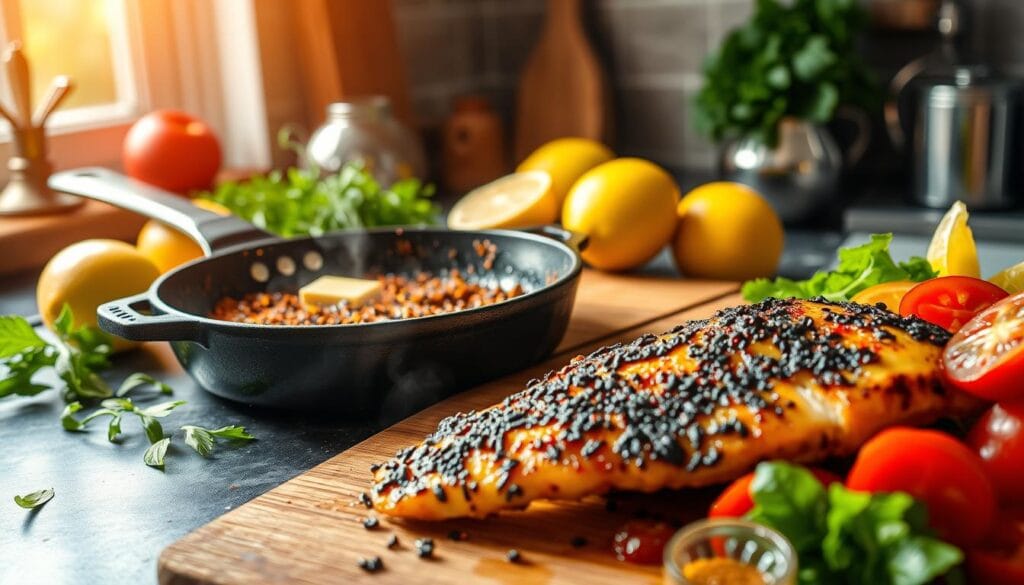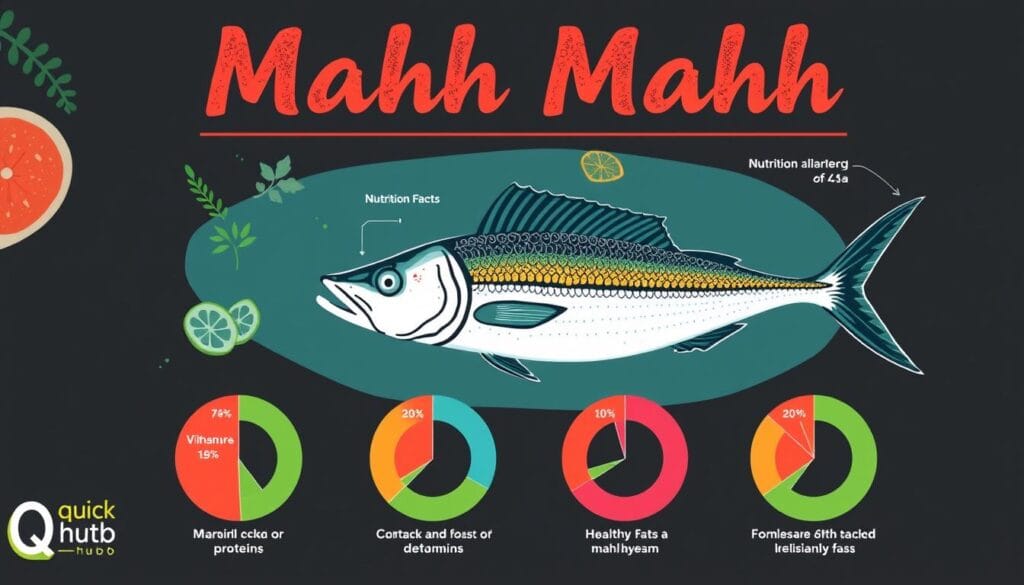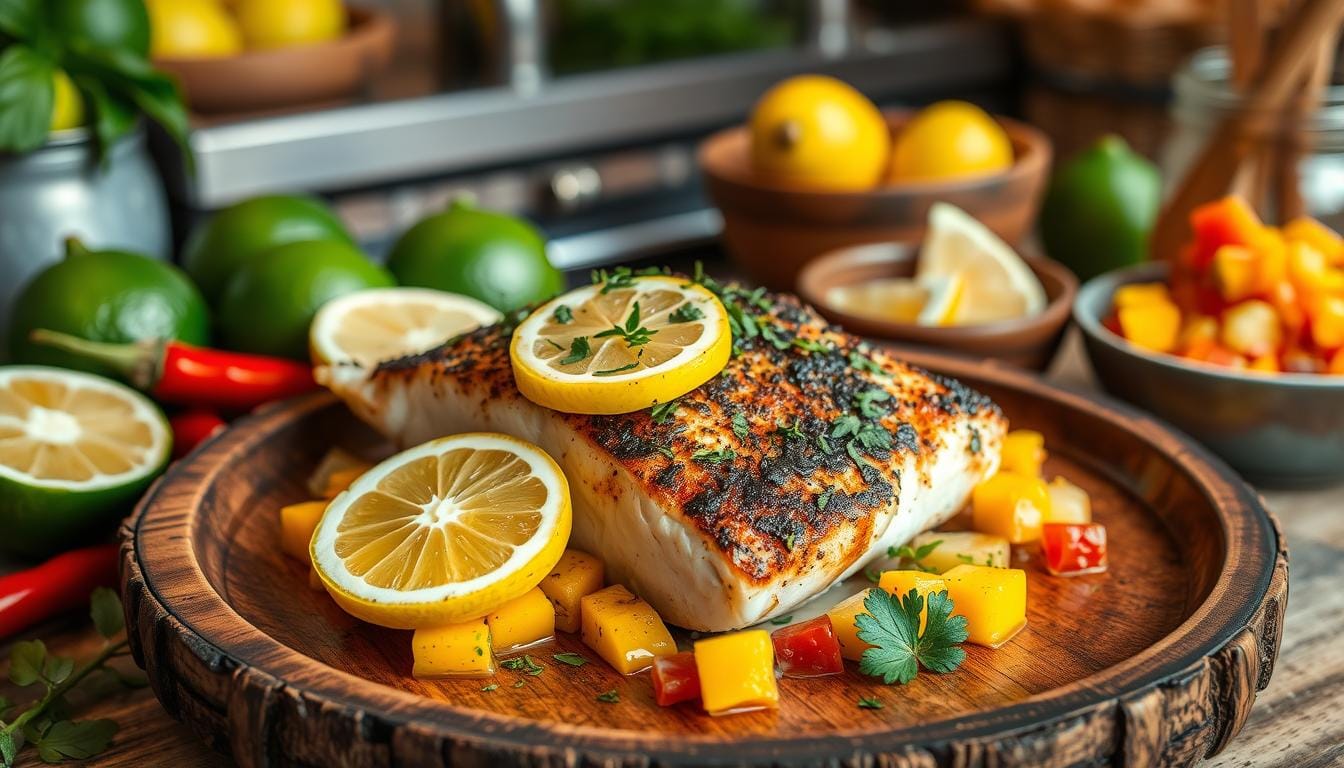Imagine a sizzling skillet and the smell of spices filling your kitchen. You’ll have a perfectly cooked fish that takes you to New Orleans. The Blackened Mahi Mahi recipe is more than food—it’s an adventure in your kitchen. It’s quick to prepare and cook, offering a gourmet seafood experience that’s both fast and tasty.
This Cajun fish recipe is a feast for your senses. Mahi Mahi, a mild white fish, becomes a star when blackened. It’s coated in spices and seared, creating a crispy outside and a juicy inside.
Table of Contents
What is Blackened Mahi Mahi?
Explore Cajun cuisine and learn about blackened fish. Blackened Mahi Mahi is a culinary gem. It turns a simple fish into a flavor and texture explosion.
Understanding the Blackening Technique
Blackening seasoning is a flavor revolution. It coats fish in a strong spice blend and sears it at high temperatures. This makes a dark, crispy outside and a tender, juicy inside.
- Requires high heat cooking
- Uses a complex spice mixture
- Creates a distinctive charred appearance
- Locks in natural fish moisture
Origins of Blackened Fish
The blackening method comes from Louisiana’s Cajun cuisine. Chef Paul Prudhomme made it famous in New Orleans in the 1980s. It quickly became a trend across the country.
“Blackening is not just cooking – it’s an art form that transforms simple ingredients into something extraordinary.” – Chef Paul Prudhomme
Mahi Mahi is perfect for blackening. Its firm flesh and mild taste soak up spices well. This makes it a top choice for blackening.
Why You Should Try This Recipe
Looking for healthy fish meals with lots of flavor? Mahi Mahi is a game-changer for your dinner table. It’s not just nutritious; it’s also exciting to eat.
Health Benefits of Mahi Mahi
Mahi Mahi is a nutritional powerhouse. It offers many health benefits:
- High protein content (32g per serving)
- Low in calories (114 kcal)
- Rich in omega-3 fatty acids (approximately 400mg per 4-ounce serving)
- Essential minerals like potassium and iron
Flavor Profile of Blackened Mahi Mahi
Blackened Mahi Mahi is a spicy fish recipe like no other. The cooking method turns this lean fish into a masterpiece. It’s coated in herbs and spices for a complex flavor that will excite your taste buds.
“Blackening is more than a cooking method—it’s an art form that elevates simple ingredients into an extraordinary meal.”
The dish gets its smoky, spicy taste from a special seasoning mix. It includes:
- Smoked paprika
- Chili powder
- Garlic powder
- Cumin
- Brown sugar
With just 30 minutes of cooking, you can make a dish that tastes like it came from a restaurant. It’s perfect for a quick dinner or to impress your guests. Blackened Mahi Mahi is sure to make your meal unforgettable.
Essential Ingredients for Blackened Mahi Mahi
To make a tasty Blackened Mahi Mahi, you need the right ingredients. These ingredients enhance the fish’s natural taste. Start your cooking journey by picking the best parts for a memorable dish.
Fresh Mahi Mahi Fillets: The Star of the Dish
Choosing the right Mahi Mahi is key. Look for fillets that are:
- Pale pink with a firm texture
- Have a fresh smell without a fishy odor
- Are about 12 oz for two people
- Each fillet weighs around 6 oz
Blackening Seasoning Components
The secret to great Mahi Mahi is in its seasoning. Your spice mix should have:
- Paprika for color and a bit of heat
- Garlic powder for depth
- Onion powder for sweetness
- Dried thyme
- Black pepper
- Cayenne pepper for spice
- Sea salt for flavor
“A perfect blackening seasoning transforms a simple fish into a culinary masterpiece.” – Chef Tom Scodari
Recommended Cooking Oils for Fish
Choosing the right oil is important for a great crust. For Mahi Mahi, try these oils:
- Avocado oil (high smoke point)
- Olive oil (rich flavor)
- Butter for extra richness
Pro tip: Pick oils with high burning points to avoid bitter tastes. This ensures a beautiful crust on your Mahi Mahi.
At just $9.99 per pound, Mahi Mahi is a tasty and affordable seafood choice. It can be cooked in just 15 minutes.
Preparing the Blackening Seasoning
Making your own blackening seasoning is simple. This recipe lets you pick the flavors for your blackened Mahi Mahi.
To make the best homemade blackening seasoning, you need the right mix of spices. Let’s explore what makes this blend special.
Step-by-Step Guide to Making the Seasoning
Here’s how to make your own spice blend:
- Gather your spices: chili powder, smoked paprika, ground cumin, cayenne pepper, black pepper, and salt
- Measure precisely:
- 3 tablespoons chili powder
- 2 teaspoons smoked paprika
- 2 teaspoons ground cumin
- 1 teaspoon cayenne pepper
- 1 teaspoon black pepper
- 1 teaspoon salt
- Mix all spices in a small bowl
- Whisk thoroughly to combine
- Taste and adjust seasonings as needed
“The secret to a great blackening seasoning is balancing heat with depth of flavor.” – Culinary Expert
Seasoning Storage Tips
Keeping your seasoning fresh is key. Store it in an airtight container, away from sunlight and heat.
| Storage Method | Duration | Recommended Location |
|---|---|---|
| Airtight Container | Up to 6 months | Pantry or Spice Cabinet |
| Refrigerated | Up to 1 year | Cool, Dark Refrigerator Shelf |
Pro tip: Label your container with the date of preparation to track freshness!
Cooking Methods for Blackened Mahi Mahi Recipe
Learning to cook blackened Mahi Mahi is all about mastering two key techniques: grilling and pan-searing. Each method adds special flavors to this tasty fish. It creates a crispy outside and a soft, flaky inside.
Grilled Fish Perfection
Grilling Mahi Mahi gives it a smoky taste that seafood fans love. Here’s how to grill it perfectly:
- Preheat grill to high heat (around 450-500°F)
- Brush fish with avocado oil to prevent sticking
- Cook for 3-4 minutes per side
- Ensure internal temperature reaches 140-145°F
Pan-Seared Mahi Mahi Techniques
Pan-searing is the top choice for a blackened fish crust that rivals restaurants. A cast-iron skillet is the best for getting that blackened flavor.
“The secret to perfect pan-seared Mahi Mahi is a scorching hot skillet and precise timing.” – Culinary Chef
| Cooking Method | Cooking Time | Temperature |
|---|---|---|
| Grilling | 6-8 minutes total | 450-500°F |
| Pan-Searing | 4-6 minutes total | Medium-high heat |
For blackened fish, use high heat, keep the fish dry before seasoning, and steer clear of nonstick pans. These tips will help you make a delicious Mahi Mahi dish that wows everyone.
Tips for Cooking Perfect Mahi Mahi
Mastering Mahi Mahi cooking tips means knowing how to check for doneness and using the right techniques. It’s not just about seasoning. It’s about cooking methods that keep the flavor and texture just right.

Cooking Mahi Mahi needs attention to detail and knowing the right temperatures. The right approach can make your seafood dish go from good to great.
Critical Cooking Temperatures
When cooking Mahi Mahi, keeping the temperature right is key. Here are some important temperature guidelines:
- Internal temperature should reach 145°F for food safety
- Cook fish until it becomes opaque and flakes easily
- Avoid overcooking to prevent dry, tough texture
Checking Fish Doneness Like a Pro
Figuring out when the fish is done right takes skill and attention. Here’s how to make sure your Mahi Mahi is cooked just right:
- Use a fork to gently test fish flakiness
- Look for a translucent center changing to opaque white
- Check for firm, moist texture without being rubbery
“The secret to perfect fish is knowing exactly when to stop cooking.”
| Cooking Method | Approximate Cooking Time | Doneness Indicator |
|---|---|---|
| Skillet Searing | 3-4 minutes per side | Golden brown crust, flaky interior |
| Grilling | 4-5 minutes total | Distinct grill marks, firm texture |
| Oven Baking | 10-12 minutes | Evenly opaque, moisture retained |
Pro tip: Always remove fish from heat when it’s slightly underdone, as residual heat will continue cooking the fish.
Serving Suggestions
To make your blackened mahi mahi dinner special, think about adding some great sides. The right choices can turn a simple meal into a memorable one.
Fresh Vegetable Companions
Choosing the right sides for your blackened mahi mahi can make your meal even better. Here are some fresh vegetable ideas:
- Garlic green beans with a crisp texture
- Grilled asparagus seasoned with herbs
- Roasted zucchini with light seasoning
- Corn on the cob for a classic touch
Ideal Side Dishes to Complement Your Fish
Your mahi mahi recipe needs sides that match its bold taste. Try these tasty options:
- Lemon brown rice for a zesty complement
- Creamy mashed potatoes
- Cajun roasted potatoes with smoky spices
- Pineapple mango salsa for a tropical twist
Pro tip: Choose sides that balance the blackened seasoning’s intensity with complementary flavors and textures.
For a lighter meal, serve your mahi mahi over mixed greens or make fish tacos for a casual meal. This dish is versatile, letting you be creative with your pairings.
How to Store Leftover Blackened Mahi Mahi
After enjoying your delicious blackened Mahi Mahi, it’s important to store it right. This keeps its flavor and quality. Knowing how to handle leftover seafood makes meal planning easier and cuts down on waste.
Refrigeration Guidelines
Here are the key steps for storing leftover Mahi Mahi:
- Cool the fish completely before storing
- Use an airtight container to prevent moisture loss
- Refrigerate within 2 hours of cooking
- Store for maximum 1-2 days in the refrigerator
Reheating Seafood Recommendations
Reheating seafood needs gentle methods to keep its texture. Here are ways to reheat your Leftover Mahi Mahi:
- Skillet Method:
- Heat skillet over medium-low heat
- Add a small amount of butter or oil
- Warm fish for 2-3 minutes per side
- Oven Method:
- Preheat oven to 275°F
- Place fish in a baking dish
- Cover with foil to prevent drying
- Heat for 10-15 minutes
Freezing Options
Freezing is a great way to keep Mahi Mahi longer:
| Storage Method | Duration | Recommended Packaging |
|---|---|---|
| Refrigerator | 1-2 days | Airtight container |
| Freezer | Up to 3 months | Vacuum-sealed bag or freezer-safe container |
Pro tip: Always label your stored fish with the date to track freshness!
Remember, stored and reheated Mahi Mahi can still be a great meal. It keeps its rich flavor and nutritional benefits.
Nutritional Information
Dive into the world of healthy fish meals with a closer look at mahi mahi. This seafood option is packed with nutrients that support your health and wellness.

Calories and Macronutrients Breakdown
A typical serving of blackened mahi mahi is a nutritional powerhouse. It’s great for those who love protein-rich seafood. Here’s a detailed look at its nutritional profile:
- Calories: 296 kcal
- Protein: 22g
- Fat: 19g
- Carbohydrates: 10g
Health Benefits of Mahi Mahi
Mahi mahi nutrition facts show it’s more than just a tasty meal. It’s a nutritional powerhouse with essential nutrients:
| Nutrient | Amount | Health Benefit |
|---|---|---|
| Omega-3 Fatty Acids | 400mg per 4 oz | Supports heart health |
| Vitamin B12 | High | Supports nervous system |
| Selenium | Significant | Boosts immune function |
“Eating mahi mahi is like giving your body a nutritional high-five!” – Nutrition Expert
Mahi mahi is a delicious and nutritious option for a healthy diet. It’s perfect for those looking to add protein to their meals.
Frequently Asked Questions
Cooking blackened Mahi Mahi can raise several questions for home chefs. We’ve compiled the most common inquiries to help you perfect your seafood preparation and explore delicious variations.
Can I Use Other Fish for This Recipe?
Blackened fish alternatives are plentiful for this recipe. You can easily substitute Mahi Mahi with other firm white fish varieties. Fish substitutions that work wonderfully include:
- Cod
- Grouper
- Halibut
- Snapper
- Tilapia
Each fish brings a unique flavor profile, but maintains the delicious essence of the blackening technique. When selecting an alternative, choose fish with similar thickness and firmness to ensure optimal cooking results.
How Spicy is the Blackened Seasoning?
Spice level adjustments are completely within your control. The heat of blackened seasoning depends on your personal preference and spice tolerance.
| Spice Level | Cayenne Pepper Amount | Flavor Profile |
|---|---|---|
| Mild | 1/4 teaspoon | Gentle warmth |
| Medium | 1/2 teaspoon | Balanced heat |
| Hot | 3/4 – 1 teaspoon | Intense spiciness |
To reduce spiciness, decrease cayenne pepper or chili powder. For more heat, add extra cayenne or include a pinch of red pepper flakes. Remember, you can always add more spice, but you can’t take it away!
“Cooking is about personal taste. Don’t be afraid to experiment with your seasoning.” – Culinary Expert
Recommended Tools for Your Cooking
Getting the perfect blackened mahi mahi is more than just using great ingredients. The right kitchen tools are key to making a dish that tastes like it came from a restaurant. Choosing the right cookware for blackened fish will make your cooking better and help you get that crispy outside.
For cooking seafood, a few important tools can change your cooking. You’ll need some essential gear for precise cooking and easy prep.
Essential Cooking Utensils
- Cast iron skillet cooking is the gold standard for blackened fish
- High-quality fish spatula for delicate handling
- Accurate meat thermometer to check fish doneness
- Sturdy mixing bowls for seasoning preparation
- Precise measuring spoons and cups
Must-Have Kitchen Gadgets
Professional chefs say the right tools are crucial for a great seafood dish. A spice grinder lets you make fresh seasoning blends that elevate your mahi mahi. Check out some quick and easy dinner recipes to go with your new cooking skills.
“The right tool is half the battle in creating a perfect meal.” – Culinary Wisdom
| Tool | Purpose | Recommended Type |
|---|---|---|
| Skillet | Even heat distribution | Cast iron, heavy-bottomed |
| Thermometer | Temperature accuracy | Digital instant-read |
| Spatula | Fish handling | Thin, flexible metal |
Investing in quality kitchen tools not only improves your cooking but also makes it more fun. Your blackened mahi mahi will be delicious!
Where to Buy Mahi Mahi
Looking for top-notch mahi mahi? You have many great places to find fresh seafood. Local seafood markets are known for their fresh catches. Fishmongers there can help you pick the best fish.
Many grocery stores also have excellent seafood counters. They often have premium mahi mahi fillets that meet FDA standards.
Frozen fish quality has gotten much better. Online seafood retailers like Sizzlefish are a great choice. They offer seafood that’s individually portioned and sealed, matching FDA serving sizes. They have over 25,000 reviews, showing they’re reliable and customer-friendly.
Online seafood delivery services are also a good option. Some, like Sizzlefish, offer free shipping on orders over $100. They also promise customer satisfaction, with refunds or replacements if needed. Remember, most Americans don’t eat enough seafood, so these options can help.
Fresh vs. Frozen Considerations
When picking mahi mahi, look at its appearance and where it came from. Fresh fish should be firm, pinkish, and have little smell. Frozen fish can be just as good and is often easier to find all year.
No matter what you choose, make sure it’s of high quality. This way, you’ll get a tasty and healthy meal.

